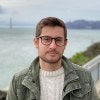Will O'Hare's revamp boost Chicago's global profile?

O'Hare International Airport is starting a renovation to build a world-class "Global Terminal." Can it help the city compete with international air travel hubs?
Chicago’s O’Hare International Airport is undergoing major renovations that, in the long term, stakeholders in tourism and international travel expect to greatly benefit the city.
The construction is a long time coming. The project, known colloquially as O’Hare 21, was first announced in 2018 by then-Mayor Rahm Emanuel, who called it “a turning point for Chicago that will create tens of thousands of jobs for Chicagoans and strengthen our great city’s position as a national and global leader in travel, tourism and trade for generations.”
After that announcement, the project was mired by years of delays (particularly amid the COVID-19 pandemic) and ballooned construction costs. But last month, it got the needed go-ahead from airline stakeholders following revisions to the construction schedule.
Some secondary parts of the project, including an eastern expansion of Terminal 5 and an upgrade for Terminal 3, are already complete or underway. It’s the O’Hare 21 tentpole, though, that was approved at last this spring — and that project, the new “Global Terminal,” is the one that could reshape Chicago’s image as an international destination.
Construction on the terminal, which will replace the current Terminal 2, is set to begin next year. Originally slated for completion in 2026, it is now expected to open in 2032.
When it does, it will include state-of-the-art baggage facilities, two million square feet of space, and a sleek design by Chicago architect Jeanne Gang — a suite of offerings that the city hopes will help O’Hare compete against more modern air travel hubs around the globe.
'Gateway to our city'
While it’s been a long road to ground-breaking, Emanuel’s original reasons for proposing the construction continue to resonate with the tourism industry. A spokesperson for Choose Chicago told ChicagoGlobal the organization is “thrilled” the construction is moving forward.
“As the gateway to our city, O’Hare is often the first Chicago landmark for international visitors, and it has long contributed to our status as a premier global destination for leisure and business travelers,” the spokesperson said.
"The construction of the new global terminal at O'Hare will help us continue to increase our international visitation numbers and remain a bucket-list destination for visitors from around the world."
For airlines, it has been less cheerful in the immediate term. The project is mostly funded by city bonds generated from airline fees, meaning in effect that airlines – especially United and American, who account for much of O’Hare’s traffic – have been left on the hook for additional costs. That led to some feet-dragging before the carriers eventually confirmed their support for the renovation this spring.
In the short term, the increased costs could mean higher ticket prices for travelers and therefore a dip in demand, if the airlines choose to pass on costs to consumers. In the long term, however, increased airport capacity would increase the supply of flights out of O’Hare.
Meeting demand for international travel
Before the pandemic, international air travel had been booming, leading to bottlenecks for existing airports that didn’t have enough capacity to keep up. That had negative effects for commercial flyers as well as local and regional industries that rely on air transportation for cargo shipping.
Aviation officials hope the O’Hare 21 project will alleviate some of that congestion here in Chicago. “[T]here will be continued opportunity for supply growth at O’Hare once the O’Hare Global Terminal Federal Inspection Services capacity and international gates come online,” Kevin Bargnes, communications director for the Chicago Department of Aviation, told ChicagoGlobal. This could eventually spell lower costs for travelers, since airfare is a highly supply-and-demand–driven consumer good. Even if that price relief doesn’t materialize, though, the city still expects the project to increase the number of passengers served by the airport — which is a trajectory with plenty of global precedents.
Major airport construction projects have led to an uptick in international travel in several other world cities. Dubai’s Concourse D, completed in 2016, helped improve airport capacity to meet increased demand for international tourism. Similar developments at London Heathrow, including the 2014 reconstruction of Terminal 2 and further expansion plans, have been billed as ways to compete more effectively for tourism and trade.
Like Dubai and Heathrow, O’Hare is already a major power in international air travel. It consistently ranks in the top 10 busiest airports in the world, and in 2023 it served more than 80 million passengers. Current international air services operate primarily from Terminal 5, making the terminal a busy one. It was built, though, in 1993 — making it somewhat outdated compared to the kinds of upscale modern airports that tend to rank among international travelers’ favorites, like Qatar’s Doha Hamad and Singapore’s Changi.
were served at O'Hare International Airport in 2023, making it one of the top 10 busiest airports in the world.
The hope for O’Hare is that the new Global Terminal will provide the capacity and quality to compete against these heavyweights. While it’s being built, though, a revamped Terminal 5 is taking on O’Hare’s growing demand for international flights. Terminal 5 completed its own renovation and expansion in early 2023, including opening 10 new gates, and Bargnes said that it’s now delivering the highest utilization of any gates at O’Hare.
While the department expects O’Hare’s expansion to help drive tourism and business travel, Bargnes noted the “prime drivers” of business and tourism in the city are its central location, diverse economy, continuous investment in infrastructure, and cultural attractions.
“A modern and efficiently managed airport can significantly support tourism growth by making destinations more accessible and attractive,” he said. “Likewise, increasing tourism requires airports to expand and modernize facilities to accommodate the growing number of visitors.”
This story first appeared in the ChicagoGlobal newsletter, a joint project of Crain's Chicago Business and the Chicago Council on Global Affairs.

